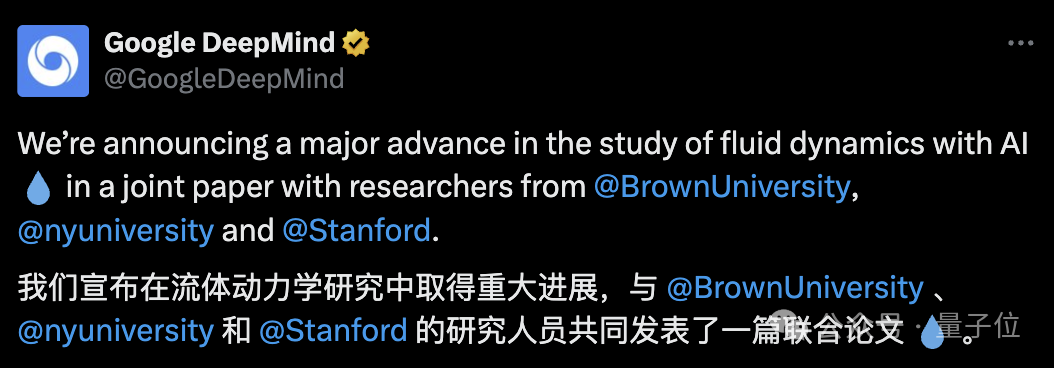https://arxiv.org/abs/2509.14185
https://zhuanlan.zhihu.com/p/1952392931752273244
Deepmind写了一篇流体力学的文章
版主: verdelite, TheMatrix
-
TheMatrix楼主

- 论坛支柱

2024年度优秀版主
TheMatrix 的博客 - 帖子互动: 268
- 帖子: 13472
- 注册时间: 2022年 7月 26日 00:35
-
TheMatrix楼主

- 论坛支柱

2024年度优秀版主
TheMatrix 的博客 - 帖子互动: 268
- 帖子: 13472
- 注册时间: 2022年 7月 26日 00:35
-
TheMatrix楼主

- 论坛支柱

2024年度优秀版主
TheMatrix 的博客 - 帖子互动: 268
- 帖子: 13472
- 注册时间: 2022年 7月 26日 00:35
#5 Re: Deepmind写了一篇流体力学的文章
Discovery of Unstable Singularities
Abstract
Whether singularities can form in fluids remains a foundational unanswered question in mathematics. This phenomenon occurs when solutions to governing equations, such as the 3D Euler equations, develop infinite gradients from smooth initial conditions. Historically, numerical approaches have primarily identified stable singularities. However, these are not expected to exist for key open problems, such as the boundary-free Euler and Navier-Stokes cases, where unstable singularities are hypothesized to play a crucial role. Here, we present the first systematic discovery of new families of unstable singularities. A stable singularity is a robust outcome, forming even if the initial state is slightly perturbed. In contrast, unstable singularities are exceptionally elusive; they require initial conditions tuned with infinite precision, being in a state of instability whereby infinitesimal perturbations immediately divert the solution from its blow-up trajectory. In particular, we present multiple new, unstable self-similar solutions for the incompressible porous media equation and the 3D Euler equation with boundary, revealing a simple empirical asymptotic formula relating the blow-up rate to the order of instability. Our approach combines curated machine learning architectures and training schemes with a high-precision Gauss-Newton optimizer, achieving accuracies that significantly surpass previous work across all discovered solutions. Crucially, for specific solutions (the Córdoba-Córdoba-Fontelos (CCF) stable and 1st unstable solutions), we reach near double-float machine precision, attaining a level of accuracy constrained only by the inherent round-off errors of the GPU hardware. This level of precision meets the stringent requirements for rigorous mathematical validation via computer-assisted proofs. This work provides a new playbook for exploring the complex landscape of nonlinear partial differential equations (PDEs) and tackling long-standing challenges in mathematical physics.
Understanding whether the partial differential equations governing fluid motion can develop singularities from smooth initial conditions – where mathematical solutions exhibit infinite gradients or velocities in finite time – represents one of the most enduring challenges in mathematics. This fundamental question spans a broad class of nonlinear fluid equations, including the incompressible 3D Euler equations [1] (first formulated in 1752), the Boussinesq equations [2] which model atmospheric flows, and the incompressible porous media (IPM) equation [3], describing fluid motion through porous materials like soil or rock. Crucial insights into these dynamics are also gained through the study of simplified analogues, such as the 1D Córdoba-Córdoba-Fontelos (CCF) model [4].
Among these systems, the 3D Navier-Stokes equations, the viscous analogue of the 3D Euler equations, represent perhaps the most famous case. The question of finite-time blow-up for Navier-Stokes is recognized as one of the seven Millennium Prize Problems [5] and the Smale Problems [6] (the 15th), with profound implications for mathematics and physics. We refer to the surveys [7, 8] for developments on this problem. If singularities can develop from smooth initial conditions, the equations predict physically impossible outcomes, such as infinite velocity gradients, in finite time. This would signal a fundamental breakdown in the predictive power of the equations.
A crucial aspect of singularity formation is stability. A singularity is considered stable if it reliably emerges from a range of initial conditions. Conversely, an unstable singularity requires infinitely precise initial conditions; any slight perturbation causes the system to deviate from the blow-up trajectory. It is hypothesized that singularities in foundational, boundary-free problems like the 3D Euler and Navier-Stokes equations must be unstable. While the presence of boundaries can stabilize solutions, developing the techniques to discover and resolve unstable singularities, even in systems with boundaries, is a critical intermediate step toward tackling the boundary-free challenge. Furthermore, it is expected that highly unstable solutions are better candidates for persisting when transitioning from idealized equations to more realistic, viscous ones, making their discovery essential for resolving these fundamental questions.
-
TheMatrix楼主

- 论坛支柱

2024年度优秀版主
TheMatrix 的博客 - 帖子互动: 268
- 帖子: 13472
- 注册时间: 2022年 7月 26日 00:35
#6 Re: Deepmind写了一篇流体力学的文章
TheMatrix 写了: 昨天 11:14If singularities can develop from smooth initial conditions, the equations predict physically impossible outcomes, such as infinite velocity gradients, in finite time. This would signal a fundamental breakdown in the predictive power of the equations.
这段写得好。singularity的意义,以及物理和数学之间的关系,一下就说清楚了。虽然很简单,也理应如此,但是我认为很多人并不清楚。



